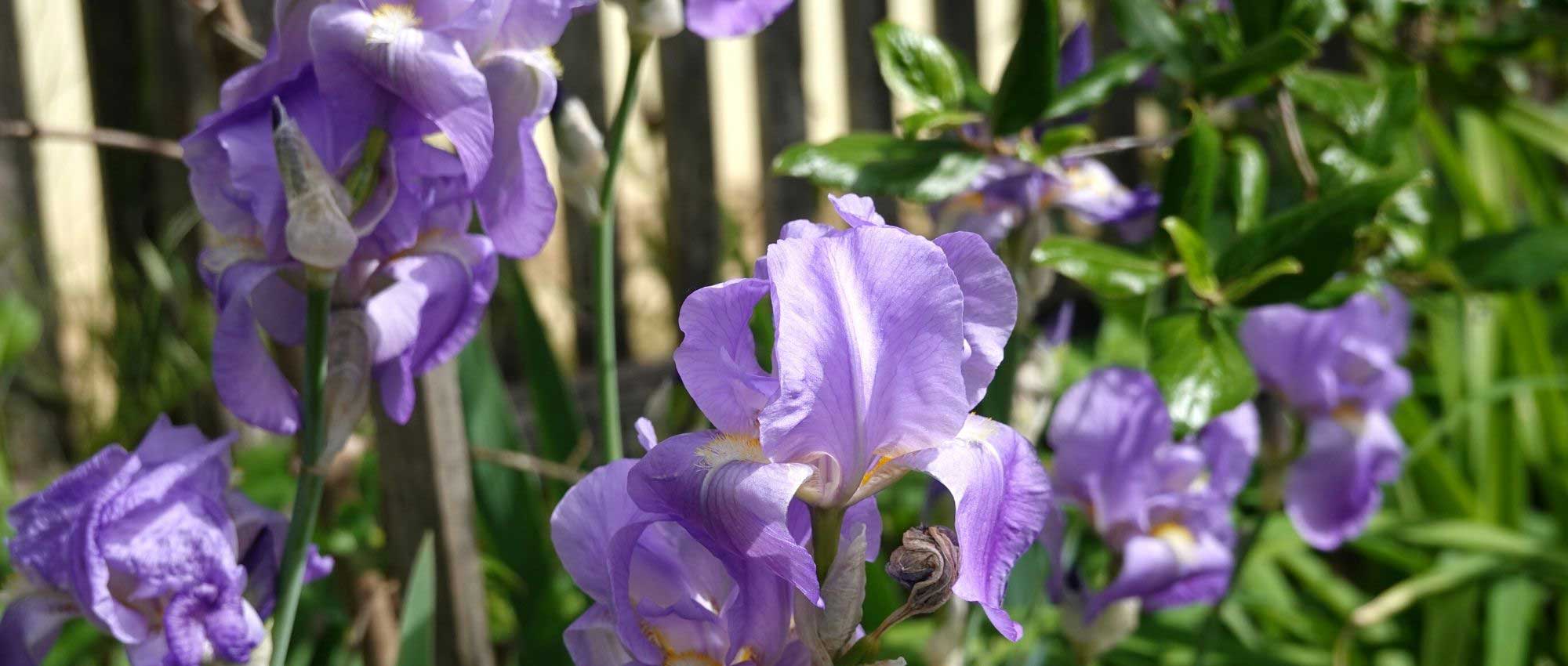
Iris germanica: 6 successful pairing ideas!
For harmonious and colourful flower beds!
Contents
German Iris, also known as garden Iris, are the most cultivated and well-known of the Iris family. They offer a spectacular flowering display in spring, between April and June, with large flowers made up of three upright petals and three trailing petals, delicately crumpled in appearance. They catch the eye and easily serve as a focal point in a border. Their upright and rigid habit adds structure to the beds. They are perfect in small clumps, to punctuate a border or a bed. In the garden, they will easily find their place in front of a façade, at the foot of a wall facing south, as this position has the advantage of sheltering them from the wind. To accompany them, avoid plants with generous foliage, large leaves, or overly tall plants that may cast shade and retain moisture. Also, avoid pairing them with spreading or ground-cover plants. Instead, choose plants with light and airy foliage. Similarly, avoid associating them with plants that require summer watering, as once flowering is finished, the rhizome of the Iris needs to be kept dry. In any case, we recommend pairing Iris with other plants that, like them, enjoy full sun and rather dry, well-drained, not overly compacted soils.
Quickly discover our ideas and inspirations for pairing Iris in the garden and creating stunning borders!
In a romantic garden
The delicate flowering of Iris germanica pairs beautifully with that of roses to create a soft and elegant border. You might consider planting it alongside a rose ‘Mary Rose’, ‘Claude Brasseur’, or ‘Old Blush’. Don’t forget about peonies! Their large, crumpled, well-rounded flowers are perfect for a romantic garden. Also enjoy the beautifully cut, silver foliage of wormwoods and the very light flowering of columbines. You can also incorporate some hardy geraniums, nepeta, and late tulips into your border. Plant a clematis nearby, which will climb over an arbour or pergola. For example, you could choose the clematis ‘White Pearl’, which offers elegant white flowers. For shrubs, consider Deutzia, Weigela, Lilac, or Viburnum opulus. In terms of colours, favour white and pink, with a few small touches of red to add intensity, as well as silver foliage, and possibly a bit of mauve or blue.
For more ideas, feel free to check out our Inspiration page – Romantic Atmosphere
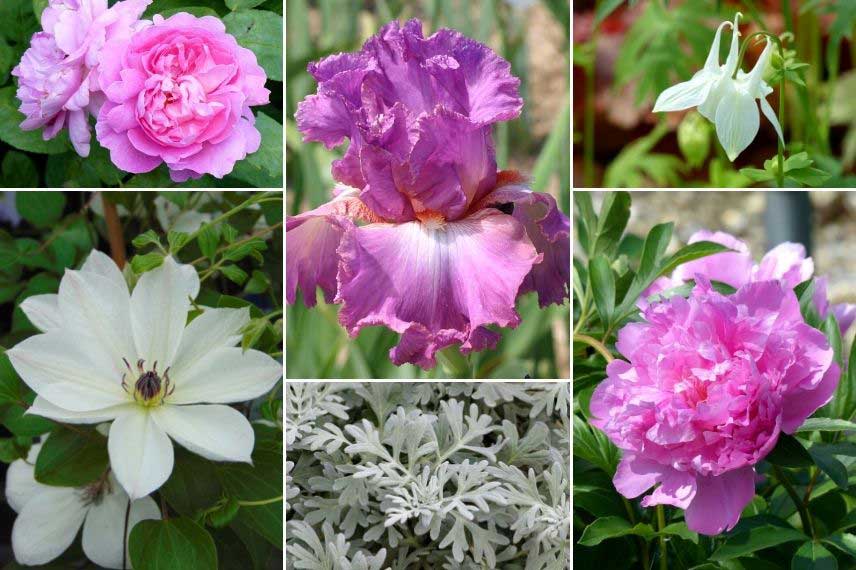
Some varieties of Iris integrate very easily into a romantic-style garden! Rose ‘Mary Rose’, Iris germanica ‘Mallow Dramatic’, Aquilegia vulgaris ‘Munstead White’, Clematis ‘White Pearl’, Artemisia stelleriana ‘Silver Brocade’, and Paeonia lactiflora ‘Monsieur Jules Elie’
In a cottage garden
Iris produce very elegant flowers, with slightly crumpled petals that have a velvety appearance, and they come in delicate shades and hues. This style of flowering is perfect for a cottage garden, typically English. This type of garden offers a lush and abundant look, very natural, with many flowers in soft tones. It is ideal for highlighting an old stone house. Choose an iris in pastel shades, such as blue, soft pink, or apricot, for example ‘English Cottage’, ‘Navajo Jewel’, or ‘Poésie’. Plant alongside foxgloves, Oriental poppies, hardy geraniums (for example ‘Johnson’s Blue’), centauries, Alliums, and salvias… Also discover Polemonium caeruleum, which offers lovely blue flowers and finely cut foliage. Enjoy the highly decorative, silvery foliage of Cynara cardunculus and Stachys byzantina. In the background, integrate Eremurus himalaicus, whose tall white flower spikes will structure the bed and add height.
If you like this style of border, check out our inspiration page Cottage Garden.

The delicate flowering of Iris is ideal in a cottage garden! Scene with Iris ‘Jane Phillips’, foxgloves ‘Suttons Apricot’, and Oriental poppy ‘Patty’s Plum’ (The Old Rectory, Haselbech – photo MAP), Iris germanica ‘Navajo Jewel’, Digitalis ‘Suttons Apricot’ (photo Clive Nichols – MAP), Geranium ‘Johnson’s Blue’, and Papaver orientale ‘Patty’s Plum’ (photo Alexandre Dulaunoy)
Discover other German Iris - Bearded Iris
View all →Available in 2 sizes
Available in 2 sizes
Available in 2 sizes
Available in 2 sizes
Available in 1 sizes
Available in 2 sizes
Available in 2 sizes
Available in 2 sizes
Available in 2 sizes
Available in 2 sizes
In a very colourful mixed border
You can also enjoy Irises to create a very colourful border. Choose a variety with bright shades: yellow, orange, red… Pair them with Salvia microphylla ‘Reve Rouge’, the geum ‘Totally Tangerine’, imperial fritillaries, Baptisia, Erysimums, and Icelandic poppies. Also discover the Euryops chrysanthemoides, which produces beautiful starry yellow flowers. You can plant alongside daisies, Leucanthemum vulgare, or Erigeron karvinskianus; their flowering will bring lightness to the border. The Iris germanica offers such a great diversity of colours that you can certainly mix different varieties together! This will allow you to enjoy a staggered flowering from April to June. Position the smaller ones at the front of the border, and the taller ones in the background. You can also pair them with the bright yellow flowers of the coronilla.
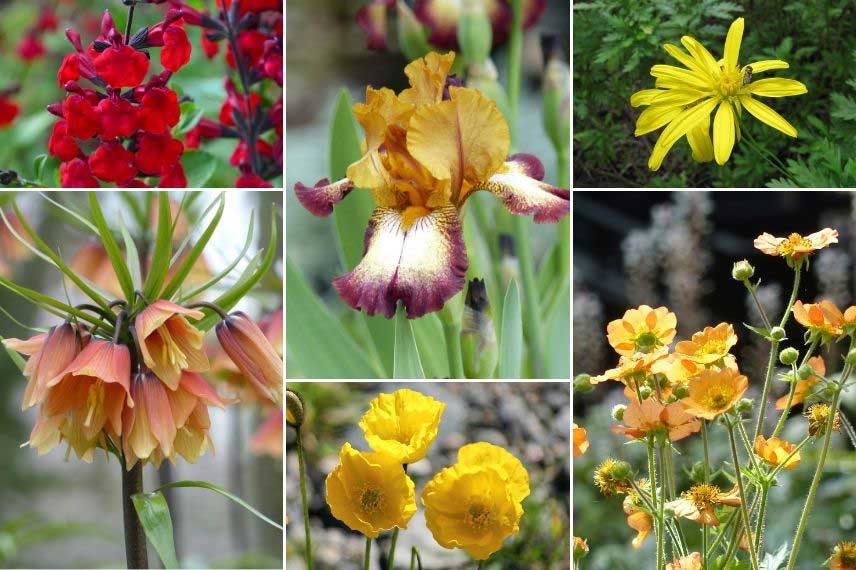
Create a very colourful border with Irises, featuring warm shades! Salvia microphylla ‘Reve Rouge’, Iris germanica ‘Flamenco’, Euryops chrysanthemoides (photo L. Enking), Fritillaria imperialis ‘Tchaikovski’, Papaver nudicaule (photo W. Pfahler), and Geum ‘Totally Tangerine’
Read also
Iris germanica: how to plant them?To play with colours, creating contrasts or harmonies of shades
The advantage of Irises is that they truly come in a wide range of colours! Thus, you can create very varied visual effects, harmonies, monochrome beds, and colour contrasts. There are irises with very dark flowers, almost black: ‘Old Black Magic’, ‘Black Suited’, ‘Ghost Train’… Enhance this dark effect by planting alongside them Geranium phaeum, purple tulips (for example, ‘Queen of Night’ or ‘Black Parrot’), Fritillaria camschatcensis or Persian fritillaries ‘Adiyaman’… All you have to do is create a lovely contrast with the bright flowering of the rose ‘Charles Darwin’ and Euphorbia polychroma ‘Bonfire’! You can also incorporate a yellow-flowered iris to make it stand out as well!
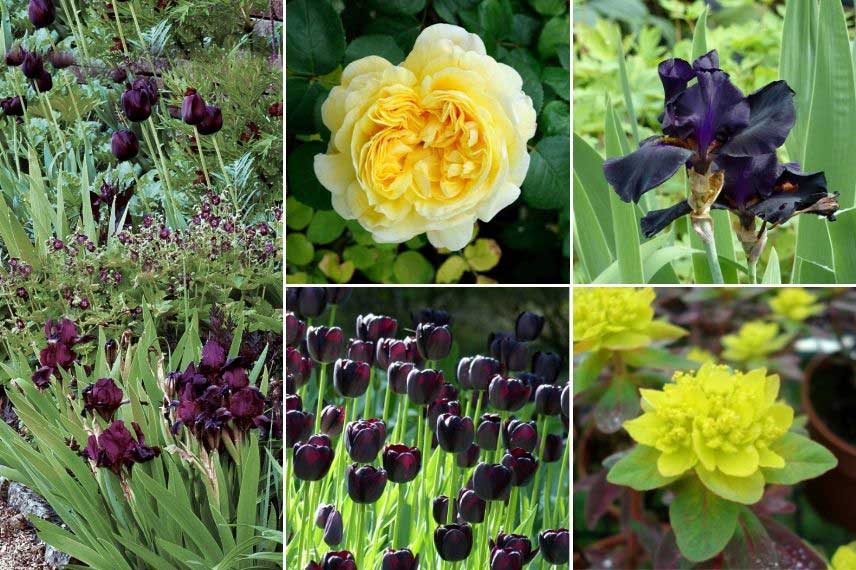
You can compose a bed with dark flowers, then integrate, for example, a yellow-flowered rose or Euphorbia polychroma to highlight their flowering and create an impressive contrast! Scene with Iris germanica ‘Ruby Contrast’, Geranium phaeum, Tulipa ‘Queen of Night’ and Tulipa Black Parrot (photo Clive Nichols – MAP), Rose ‘Charles Darwin’, Iris germanica ‘Old Black Magic’, Tulip ‘Queen of Night’ and Euphorbia polychroma ‘Bonfire’
In a naturalistic garden, with light and airy flowerings
With their very upright leaves and large flowers, Irises have a rigid and imposing, structuring appearance. This allows for the creation of lovely contrasts in shape by pairing them with plants that have a very free and airy, flexible habit. Think, for example, of columbines, Erigeron karvinskianus, Thalictrum, Erysimum ‘Bowles Mauve’, Senecio polyodon, Centranthus ruber… Also enjoy the charming pink flowers of the Gladiolus byzantinus, and the airy flowering of gypsophila. Don’t forget the grasses, such as the stunning Stipa gigantea, which bears very tall flower spikes, reaching up to 2 m! Grasses are indeed essential in this style of border; they will give your garden a wild meadow feel!
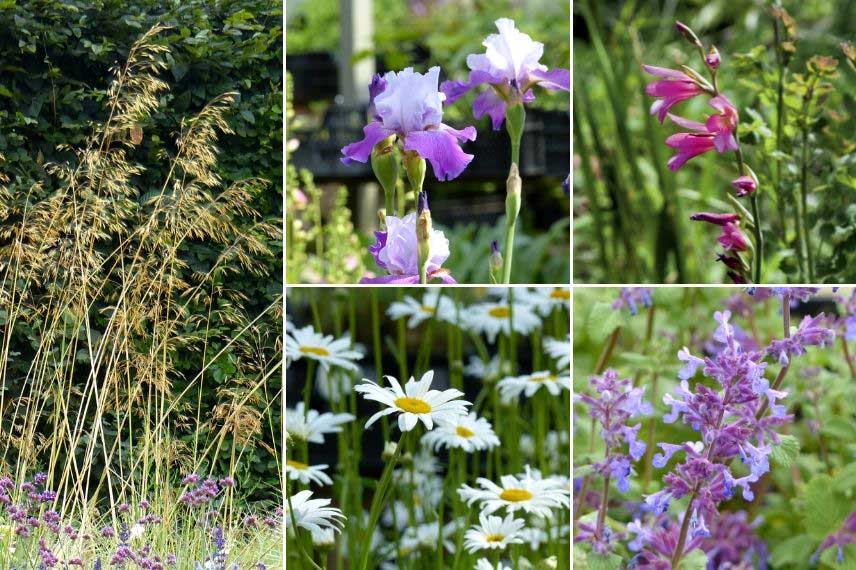
Integrate Irises with plants that have very light flowering, to create a naturalistic style border! Stipa gigantea, Iris germanica ‘Carl and Sissy’, Gladiolus byzantinus, Leucanthemum vulgare ‘Maikonigin’ and Nepeta racemosa ‘Grog’
In a scree garden or gravel garden
As Iris germanica thrives in well-drained soils and dislikes stagnant moisture, it can easily find its place in a mineral garden or scree garden. Plant it alongside other drought-resistant plants, such as Helianthemums, Phlomis fruticosa, Centranthus ruber, nepeta, butterfly lavenders Lavandula stoechas, Salvia nemorosa, Euphorbia myrsinites, and Verbascum. Also consider the silver foliage of Stachys byzantina or santolina. Integrate some clumps of grasses, such as Stipa or blue fescue, which will add structure and lightness. This style of planting has the advantage of grouping drought-resistant plants that require little attention and are water-efficient.
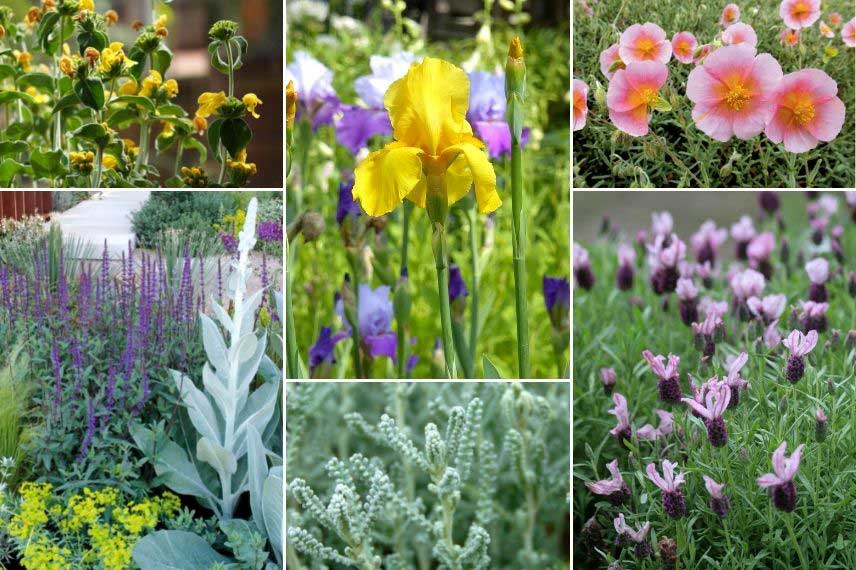
You can also incorporate Irises into a dry, Mediterranean-style garden with plants that tolerate drought! Phlomis fruticosa, Iris germanica ‘Ola Kala’, Helianthemum ‘Rhodanthe Carneum’, dry mass scene with Verbascum ‘Polarsommer’, Salvia nemorosa ‘Caradonna’, and Euphorbia myrsinites (photo Nathalie Pasquel – MAP), Santolina chamaecyparissus, and Lavandula stoechas ‘Madrid Purple’
- Subscribe!
- Contents
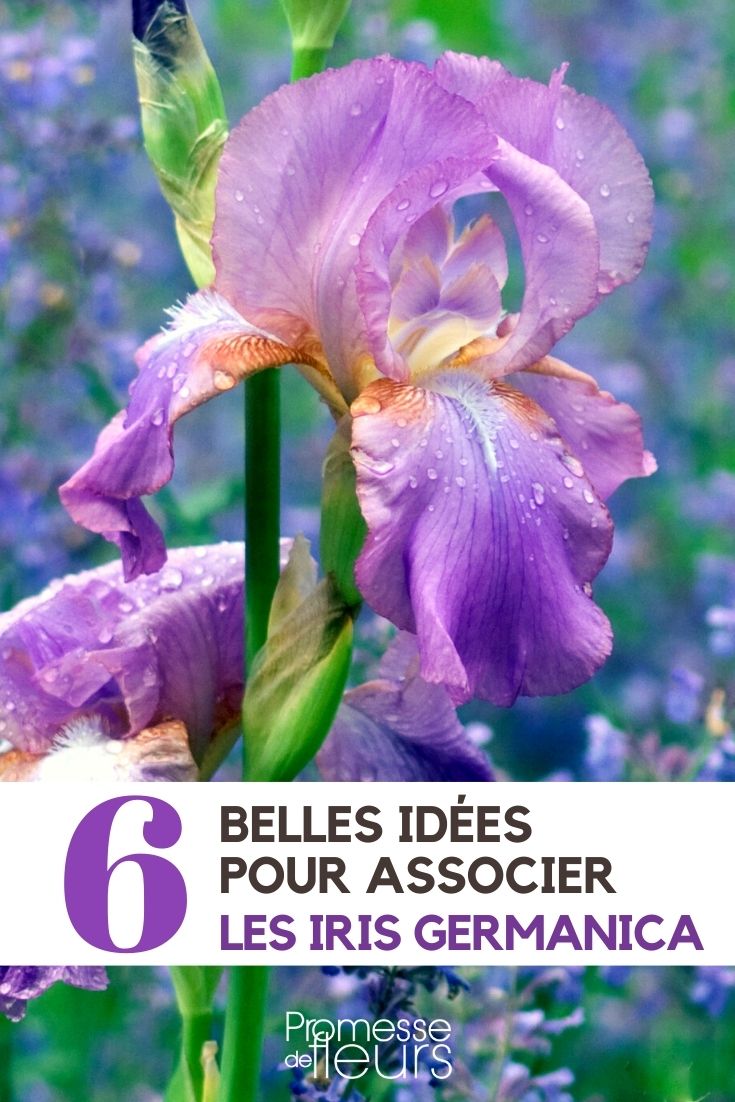































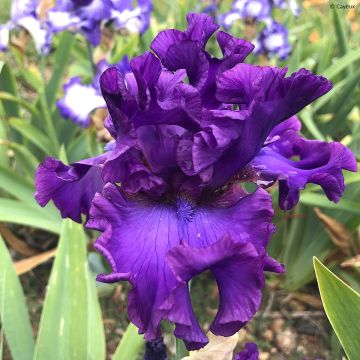
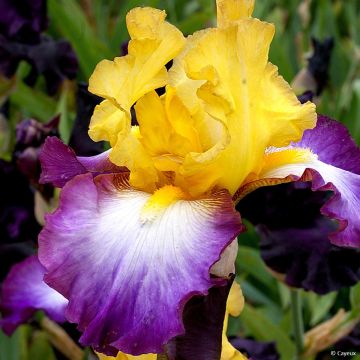
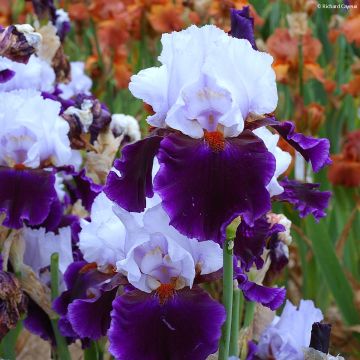
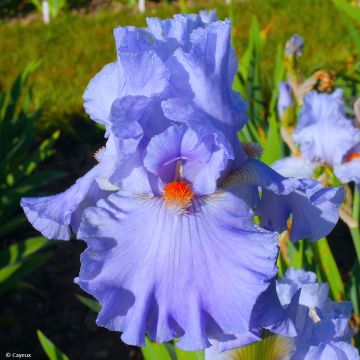
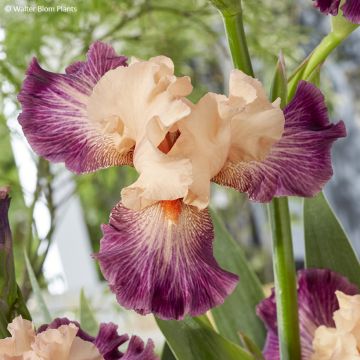
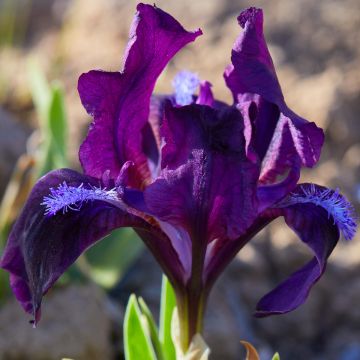
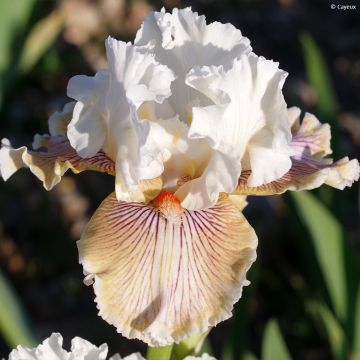
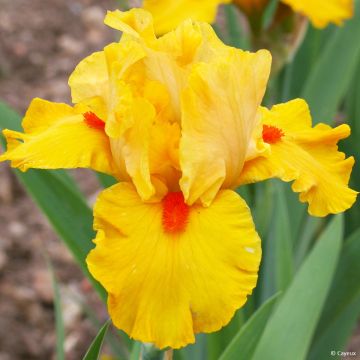
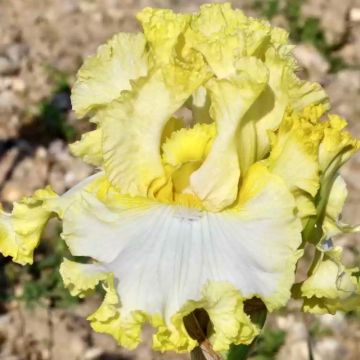
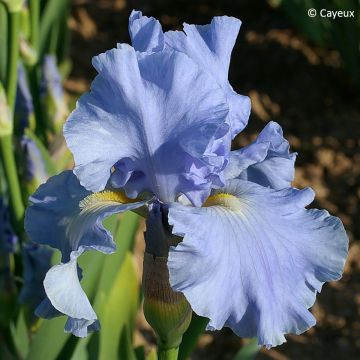
Comments